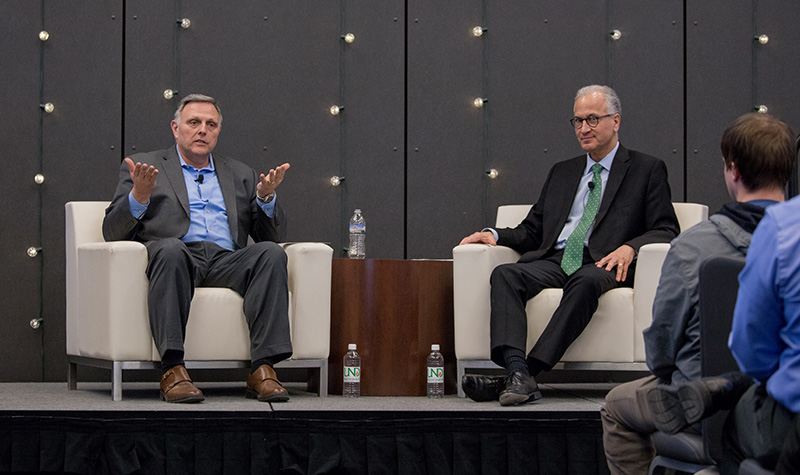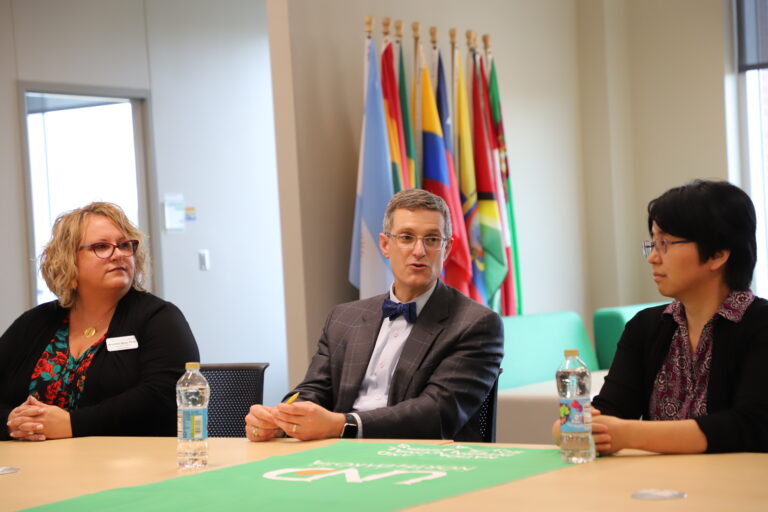Eye of the Hawk: Knowing the dangers
Homeland Security Under Secretary examines pervasiveness of tech, how students can help defend nation

Knowing he was talking to a hockey university, William Bryan evoked the spirit of Wayne Gretzky during his Eye of the Hawk lecture, Tuesday evening.
“A good hockey player skates to the puck,” he quoted. “A great hockey player skates to where the puck is going to be.”
When it comes to the Science and Technology Directorate (S&T), the research and development arm of the U.S. Department of Homeland Security (DHS), Bryan says his team can’t afford to be anything other than great.
Acting as Under Secretary for S&T since 2017, with decades of public and federal service to boot, Bryan had an expert’s perspective on the state of technology abroad, and the position of the United States in a rapidly evolving landscape. His lecture was the seventh in the Eye of the Hawk Lecture Series created by President Mark Kennedy and First Lady Debbie Kennedy.
Modern R&D
Time is a luxury that today’s world of research and development doesn’t have.
“We don’t have time to wait three or four years for an answer,” Bryan said. “Because we’ll be so far behind the threat, behind the technology, that we’re not going to be able to make an impact.”
He pointed to the pervasiveness of tech in today’s society. Just as everyone can utilize everyday hardware and software to accomplish both menial and monumental tasks, those same tools can be used to disrupt and destroy. Bryan says as soon as the U.S. develops a deterrent technology, or policy, enemies adapt or find a way around it.
It’s the job of his directorate to constantly contemplate how technology, ideally developed for the benefit of mankind, can be harnessed to cause harm – the security of the nation depends on it.
Unmanned aircraft systems stood as a prime example. Bryan lauded the University’s role in “leading the charge” with UAS development, and the state’s leadership in testing and integrating UAS in the national airspace. He specifically pointed to the Department of Transportation’s UAS Pilot Integration Program and the local Northern Plains UAS Test Site as molding how the entire country adopts UAS technologies.
The benefits are clear, says Bryan. Package delivery, infrastructure inspection, emergency response and remote sensing represent merely a slice of what UAS technology can enhance. All the same, there needs to be assurance that drones sharing airspace aren’t delivering harmful payloads, or violating the privacy of citizens.
Bryan extended this reasoning to our lives being connected to the Internet of Things. Whether it’s security monitoring at the front door of your home, or a video feed of your nursery to keep tabs on your child, that data stream is vulnerable.
“I can guarantee that if you can see it, someone else can,” Bryan said. “Anything you can plug into, someone else can see whatever you’re seeing. We have to be knowledgeable, and at the DHS these are the issues we have to look at.”

Enabling students
One could let their mind endlessly wander in the ways technology can be turned against us, Bryan says, but the approach to the future should not be one of fear.
“I’m telling you all of this because I don’t want you to be afraid of it,” he said. “I want you to take responsibility for it. You cannot allow bad actors to steal your future capability that this technology will provide. You are our future innovators.”
Bryan launched into how readily the DHS provides funding to those who have ideas, inside or outside of the federal government. The S&T directorate has the ability to procure and hire more than any other extension of the DHS. Congress provided them a wide range of authorities to get the best and brightest working on solutions.
Their most public calls to action are prize competitions. Bryan detailed the Opioid Detection Challenge, which offers up to $1.55 million as a reward for identifying technologies that help disrupt the flow of opioids entering the United States.
Legitimate, international mail services have been identified by the DHS as a route for dangerous drugs entering the country. Large-scale drug trafficking can occur by small packages sent by mail, and the DHS is looking for ways to scan packages, en masse, to identify specific substances.
“Our programs enable students like you, sitting in the student union, collaborating with your friends, to solve a problem and get that answer to the DHS to solve a critical need,” Bryan said. “You can be in your dorm room – it can be your laboratory.”

Team effort
Kennedy joined Bryan in the second half, asking questions of departmental culture, cybersecurity, government/corporate collaboration and the roles of universities in securing the nation.
“Venues like this are important to get the word out,” Bryan said of his department’s need for problem-solvers. Universities play a part in engaging young people to find solutions, as well as connect them to internships in government. The acting under secretary took notice of Skalicky Tech Incubator on his way to the lecture, and encouraged UND to maintain partnerships with innovators.
“Keep those relationships going,” Bryan said. “Innovation is a team sport – the government is open for business and we want that kind of interaction going forward.”



